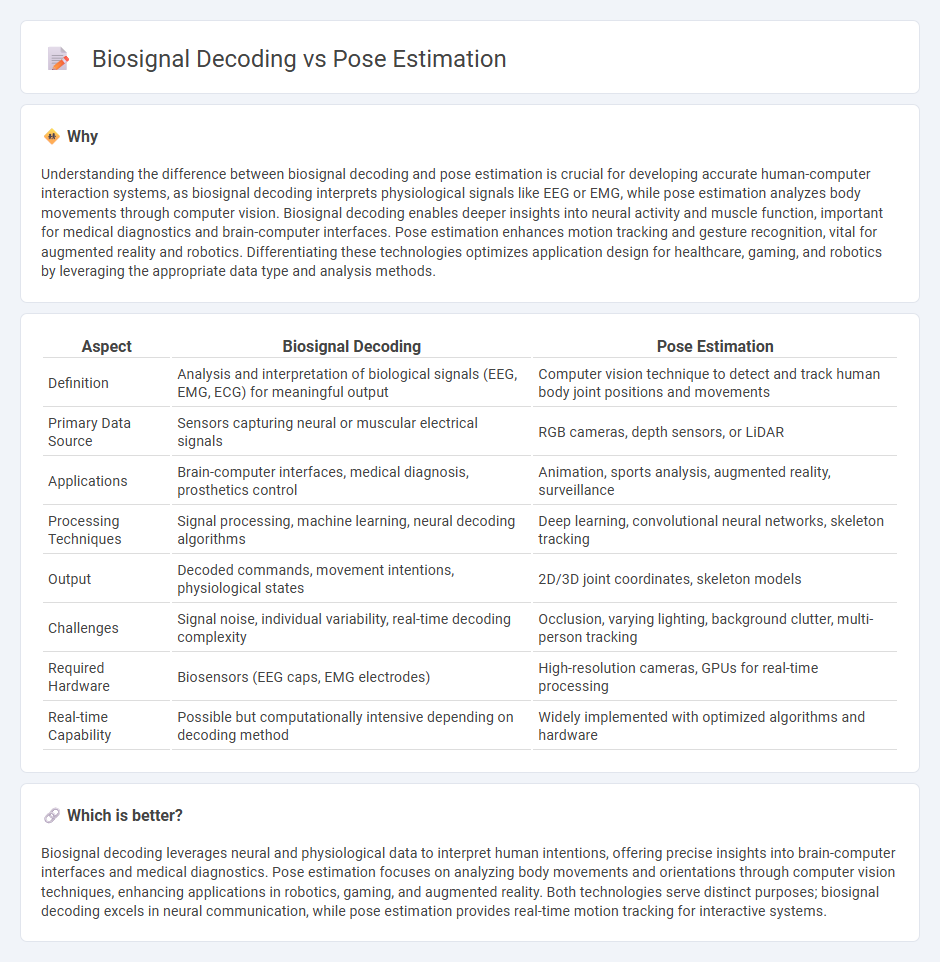
Biosignal decoding translates neurological or physiological signals into meaningful data, enabling advanced brain-computer interfaces and medical diagnostics. Pose estimation analyzes human body positions through visual data, enhancing applications in animation, robotics, and augmented reality. Explore the cutting-edge techniques driving innovation in biosignal decoding and pose estimation.
Why it is important
Understanding the difference between biosignal decoding and pose estimation is crucial for developing accurate human-computer interaction systems, as biosignal decoding interprets physiological signals like EEG or EMG, while pose estimation analyzes body movements through computer vision. Biosignal decoding enables deeper insights into neural activity and muscle function, important for medical diagnostics and brain-computer interfaces. Pose estimation enhances motion tracking and gesture recognition, vital for augmented reality and robotics. Differentiating these technologies optimizes application design for healthcare, gaming, and robotics by leveraging the appropriate data type and analysis methods.
Comparison Table
| Aspect | Biosignal Decoding | Pose Estimation |
|---|---|---|
| Definition | Analysis and interpretation of biological signals (EEG, EMG, ECG) for meaningful output | Computer vision technique to detect and track human body joint positions and movements |
| Primary Data Source | Sensors capturing neural or muscular electrical signals | RGB cameras, depth sensors, or LiDAR |
| Applications | Brain-computer interfaces, medical diagnosis, prosthetics control | Animation, sports analysis, augmented reality, surveillance |
| Processing Techniques | Signal processing, machine learning, neural decoding algorithms | Deep learning, convolutional neural networks, skeleton tracking |
| Output | Decoded commands, movement intentions, physiological states | 2D/3D joint coordinates, skeleton models |
| Challenges | Signal noise, individual variability, real-time decoding complexity | Occlusion, varying lighting, background clutter, multi-person tracking |
| Required Hardware | Biosensors (EEG caps, EMG electrodes) | High-resolution cameras, GPUs for real-time processing |
| Real-time Capability | Possible but computationally intensive depending on decoding method | Widely implemented with optimized algorithms and hardware |
Which is better?
Biosignal decoding leverages neural and physiological data to interpret human intentions, offering precise insights into brain-computer interfaces and medical diagnostics. Pose estimation focuses on analyzing body movements and orientations through computer vision techniques, enhancing applications in robotics, gaming, and augmented reality. Both technologies serve distinct purposes; biosignal decoding excels in neural communication, while pose estimation provides real-time motion tracking for interactive systems.
Connection
Biosignal decoding interprets physiological data such as EEG or EMG signals to understand neural or muscular activity, which directly informs pose estimation by translating these signals into precise body movement predictions. Advanced algorithms integrate biosignal inputs with computer vision techniques to enhance the accuracy and responsiveness of pose estimation systems in real time. This synergy enables applications in rehabilitation, human-computer interaction, and augmented reality by providing detailed insights into user motion from underlying biological signals.
Key Terms
Keypoint Detection
Keypoint detection in pose estimation involves identifying specific body landmarks from images or videos to analyze human movement, leveraging advanced computer vision and deep learning techniques. Biosignal decoding focuses on interpreting physiological signals such as EEG or EMG to infer body posture or gestures, often used in brain-computer interfaces and rehabilitation. Explore the latest advancements in keypoint detection and biosignal decoding to understand their distinct applications and integration potentials.
Electrophysiology
Pose estimation in electrophysiology involves analyzing neural signals to infer body or limb positions, leveraging techniques like EEG or EMG to track motor activity. Biosignal decoding focuses on interpreting complex neural data to understand physiological states or intentions, using advanced algorithms to extract meaningful patterns from electrophysiological measurements. Explore the latest advancements to understand how these approaches enhance human-computer interaction and neuroprosthetic development.
Machine Learning
Pose estimation leverages machine learning algorithms to analyze visual data and accurately predict human body positions, using convolutional neural networks (CNNs) and recurrent neural networks (RNNs) for spatial and temporal feature extraction. Biosignal decoding applies machine learning techniques such as support vector machines (SVMs) and deep learning models to interpret physiological signals like EEG, EMG, and ECG for detecting user intent or health states. Explore advanced machine learning strategies in pose estimation and biosignal decoding to enhance real-time applications and human-computer interaction.
Source and External Links
3D Pose Estimation - A process of predicting the transformation of an object from a reference pose using images or 3D scans.
Human Pose Estimation - Everything You Need to Know - A comprehensive overview of human pose estimation, focusing on detecting and tracking body parts in images and videos.
Pose Estimation - A task involving the identification of specific keypoints in images, often used for object or human pose detection.
 dowidth.com
dowidth.com